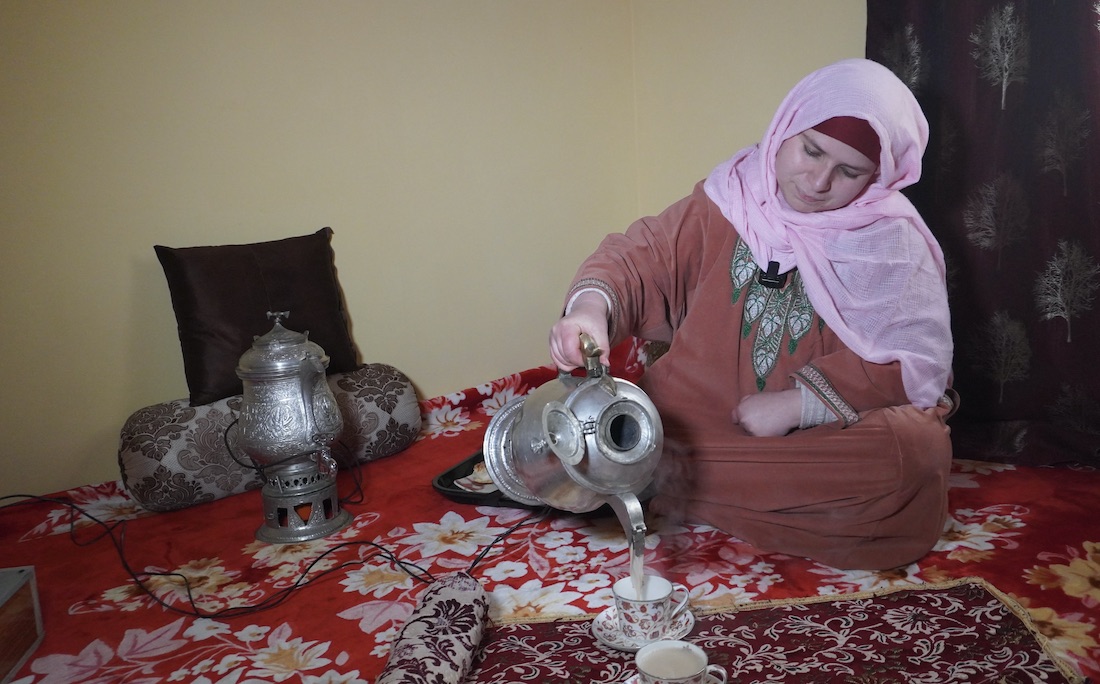Shazia Jan’s transformation of the traditional charcoal-fed Samovar into modern prototypes fuelled by LPG and electricity has fetched her recognition at the highest level, reports Hashim Bilal
Shazia Jan, a native of Chak Badwani, Qazigund, has ingeniously modernised the traditional Samovar into gas and electronic prototypes. It is a copper container traditionally used for making Kashmir’s famed Nun Chai, the slat tea. With its origins in erstwhile Russia, it came to Kashmir from Central Asia and is a key household requirement. Samovar requires charcoal for heating. Now Jan improved and used an alternative source of energy for heating up the device.
One fateful day, Shazia realised that the Samovar, a cherished symbol of Kashmiri culture, had diminished in prominence and dwarfed in competition with modern kettles. Driven by curiosity, she investigated the reasons behind this decline and discovered that it was primarily attributed to changing lifestyles, where the traditional brewing method of the Samovar was perceived as time-consuming compared to modern alternatives.
Armed with this insight, Shazia embarked on a mission to explore potential modifications that could revitalise this cultural icon and make it more accessible and appealing to contemporary users. Recognising the lack of suitable equipment in the market, she rolled up her sleeves and began crafting the necessary tools to refine and reinvent the Samovar.
Her first innovation was to transform the traditional charcoal-fuelled Samovar into a gas-powered version. She achieved this by filling the bottom of the device with gas and attaching a burner to the upper section. To enhance convenience, the gas key was strategically fixed on the outside for easy access. With this prototype, the process of preparing tea was significantly streamlined, taking approximately 10 to 12 minutes, a notable improvement from the traditional method.
However, the path to this innovation was not without its challenges. Shazia Jan encountered numerous obstacles and setbacks during the initial creation of this prototype, and it was only after an impressive 15 attempts that she finally achieved success, demonstrating her unwavering determination and perseverance.
Undeterred by the challenges, Shazia continued to push the boundaries of innovation, embarking on the creation of an electric prototype. Drawing inspiration from modern appliances such as induction heaters, she seamlessly incorporated components like relays, a cut-out mechanism, and a timer into her design.
The Challenges
These innovative features were strategically integrated to address common challenges encountered during tea preparation. The relays ensured optimal energy distribution, while the cut-out mechanism served as a fail-safe, preventing overheating or excessive brewing. The timer functionality offered precise control over the brewing process, guaranteeing perfect tea within a short time limit of 6 to 10 minutes, catering to the fast-paced lifestyles of modern consumers.
Yet, Shazia Jan’s vision extended beyond these individual prototypes. Her latest development of this cultural relic is a versatile three-in-one prototype, capable of functioning with charcoal, LPG, and electricity to cater to the diverse needs and preferences of users. This multifaceted prototype efficiently brews tea while prioritising convenience for its users.

An Innovative Design
Incorporating an automatic system, this innovative design ensures peace of mind, allowing women engaged in household tasks to delegate their attention to other chores without worrying about tea overflowing or being under-brewed. From the traditional charm of coal to the efficiency of LPG and the convenience of electricity, this prototype seamlessly combines heritage with innovation, bridging the gap between tradition and modernity.
Shazia Jan’s journey was not without its supporters and champions. One day, she crossed paths with a government employee who was actively seeking out local innovators. Impressed by her work and its potential impact, he facilitated an introduction to the late G M Bhat from Kashmir University, whose mentorship and guidance proved invaluable for her journey.
The NIF Help
Through their support and advocacy, Shazia Jan was introduced to the National Innovation Foundation (NIF), which recognised the significance of her innovations. The NIF provided financial support and assistance in patenting her creations, empowering her to bring her ideas to fruition and share them with a wider audience.
Emboldened by the backing of the NIF, Shazia embarked on the task of creating 10 prototypes of her modified innovations, a testament to her dedication and commitment to her craft.
The culmination of Shazia Jan’s efforts was marked by a felicitation ceremony at Rashtrapati Bhavan, New Delhi, in 2016, where her achievements were celebrated on a national stage. Besides, the Central University of Kashmir recognised her extraordinary contributions and honoured her for her remarkable innovations, further solidifying her place as a trailblazer in her field.
Now settled, Shazia appreciates the unwavering support of her husband. His encouragement, particularly in allowing her to travel for exhibition purposes, has been a driving force behind her continued success. She said her father and husband have been pillars of her strength throughout her journey.















